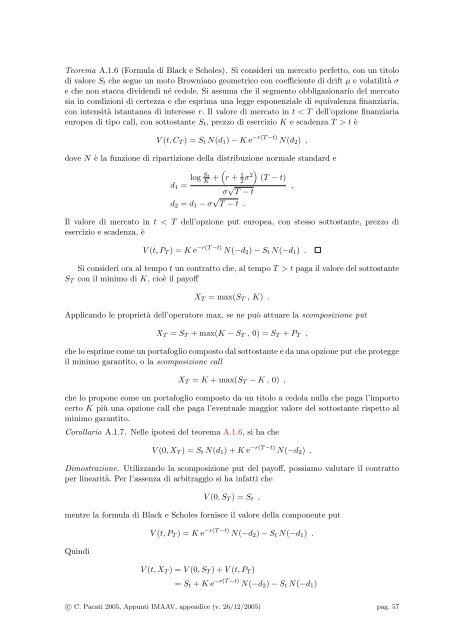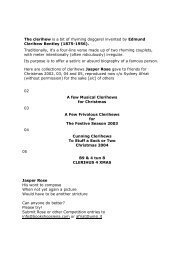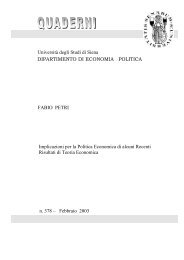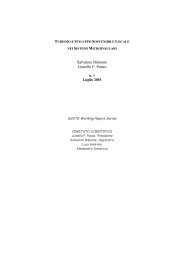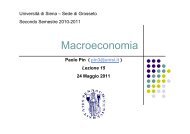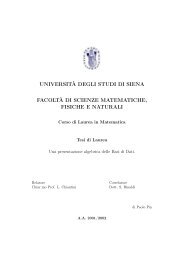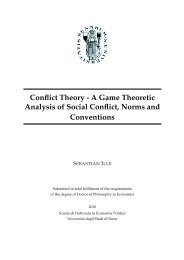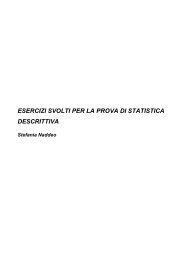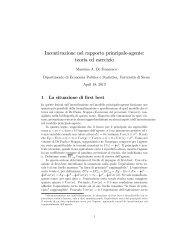Appunti delle lezioni di istituzioni di matematica attuariale per le ...
Appunti delle lezioni di istituzioni di matematica attuariale per le ...
Appunti delle lezioni di istituzioni di matematica attuariale per le ...
Create successful ePaper yourself
Turn your PDF publications into a flip-book with our unique Google optimized e-Paper software.
Teorema A.1.6 (Formula <strong>di</strong> Black e Scho<strong>le</strong>s). Si consideri un mercato <strong>per</strong>fetto, con un titolo<br />
<strong>di</strong> valore St che segue un moto Browniano geometrico con coefficiente <strong>di</strong> drift µ e volatilità σ<br />
e che non stacca <strong>di</strong>viden<strong>di</strong> né cedo<strong>le</strong>. Si assuma che il segmento obbligazionario del mercato<br />
sia in con<strong>di</strong>zioni <strong>di</strong> certezza e che esprima una <strong>le</strong>gge esponenzia<strong>le</strong> <strong>di</strong> equiva<strong>le</strong>nza finanziaria,<br />
con intensità istantanea <strong>di</strong> interesse r. Il valore <strong>di</strong> mercato in t < T dell’opzione finanziaria<br />
europea <strong>di</strong> tipo call, con sottostante St, prezzo <strong>di</strong> esercizio K e scadenza T > t è<br />
V (t, CT ) = St N(d1) − K e −r(T −t) N(d2) ,<br />
dove N è la funzione <strong>di</strong> ripartizione della <strong>di</strong>stribuzione norma<strong>le</strong> standard e<br />
d1 =<br />
log St<br />
K +<br />
d2 = d1 − σ √ T − t .<br />
<br />
r + 1<br />
2σ2 (T − t)<br />
σ √ T − t<br />
Il valore <strong>di</strong> mercato in t < T dell’opzione put europea, con stesso sottostante, prezzo <strong>di</strong><br />
esercizio e scadenza, è<br />
V (t, PT ) = K e −r(T −t) N(−d2) − St N(−d1) .<br />
Si consideri ora al tempo t un contratto che, al tempo T > t paga il valore del sottostante<br />
ST con il minimo <strong>di</strong> K, cioè il payoff<br />
XT = max(ST , K) .<br />
Applicando <strong>le</strong> proprietà dell’o<strong>per</strong>atore max, se ne può attuare la scomposizione put<br />
XT = ST + max(K − ST , 0) = ST + PT ,<br />
che lo esprime come un portafoglio composto dal sottostante e da una opzione put che protegge<br />
il minimo garantito, o la scomposizione call<br />
XT = K + max(ST − K , 0) ,<br />
che lo propone come un portafoglio composto da un titolo a cedola nulla che paga l’importo<br />
certo K più una opzione call che paga l’eventua<strong>le</strong> maggior valore del sottostante rispetto al<br />
minimo garantito.<br />
Corollario A.1.7. Nel<strong>le</strong> ipotesi del teorema A.1.6, si ha che<br />
V (0, XT ) = St N(d1) + K e −r(T −t) N(−d2) .<br />
Dimostrazione. Utilizzando la scomposizione put del payoff, possiamo valutare il contratto<br />
<strong>per</strong> linearità. Per l’assenza <strong>di</strong> arbitraggio si ha infatti che<br />
V (0, ST ) = St ,<br />
mentre la formula <strong>di</strong> Black e Scho<strong>le</strong>s fornisce il valore della componente put<br />
Quin<strong>di</strong><br />
V (t, PT ) = K e −r(T −t) N(−d2) − St N(−d1) .<br />
V (t, XT ) = V (0, ST ) + V (t, PT )<br />
= St + K e −r(T −t) N(−d2) − St N(−d1)<br />
c○ C. Pacati 2005, <strong>Appunti</strong> IMAAV, appen<strong>di</strong>ce (v. 26/12/2005) pag. 57<br />
,


